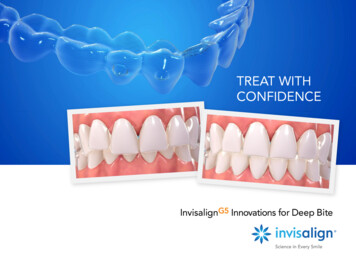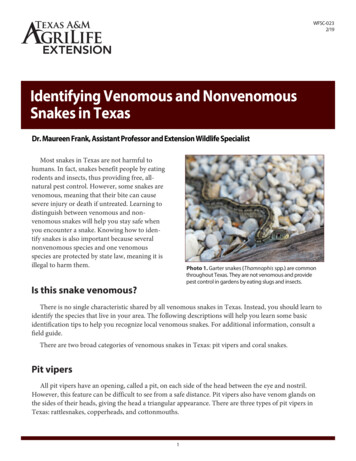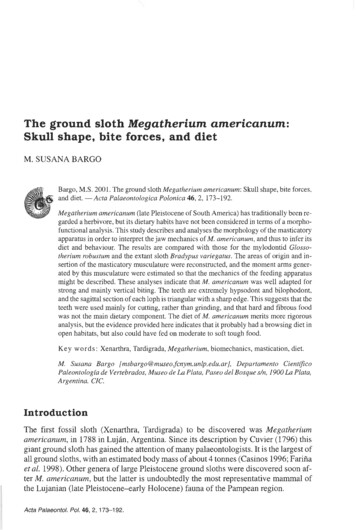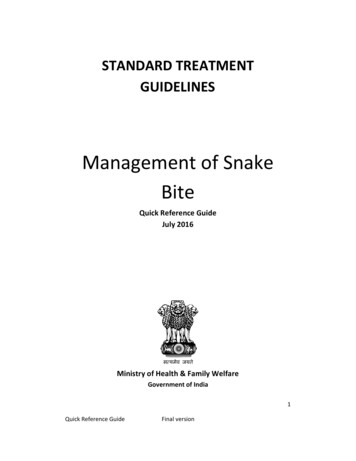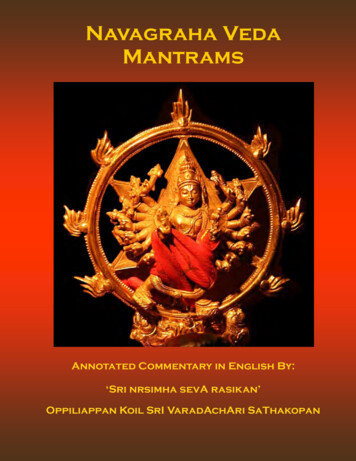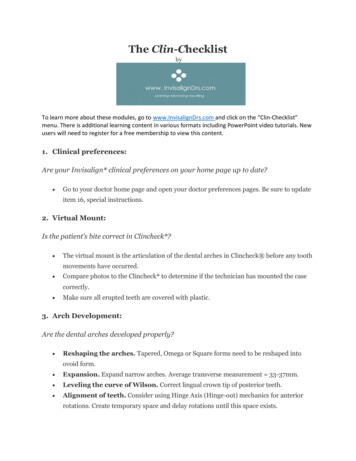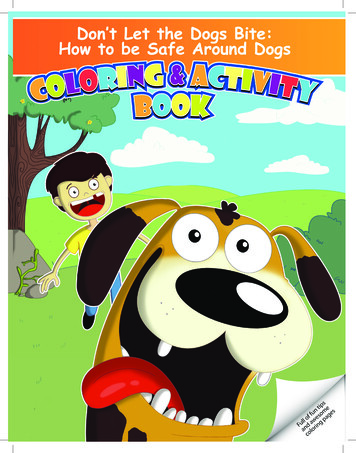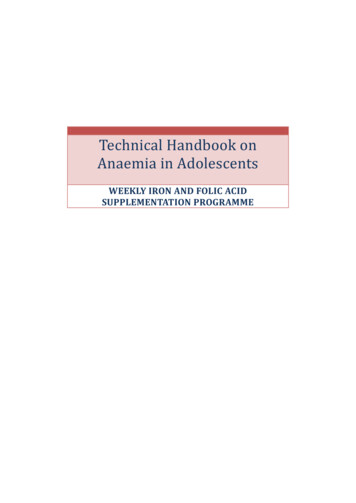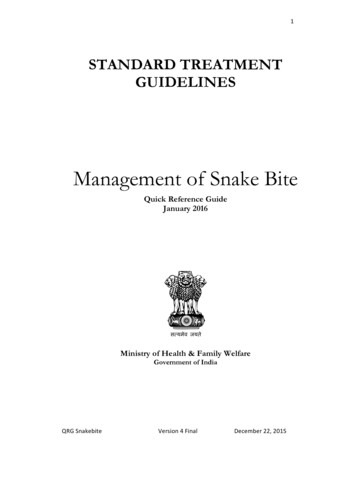
Transcription
1STANDARD TREATMENTGUIDELINESManagement of Snake BiteQuick Reference GuideJanuary 2016Ministry of Health & Family WelfareGovernment of IndiaQRG SnakebiteVersion 4 FinalDecember 22, 2015
2Table of Content1.INTRODUCTION . 42.INCIDENCE OF SNAKE BITE IN INDIA . 53.WHEN TO SUSPECT/RECOGNIZE . 64.RECOMMENDATIONS . 84.1 FIRST AID MEASURES . 84.2 SIGN & SYMPTOMS . 104.3. ASSESSMENT . 174.4 LAB INVESTIGATIONS . 184.5 ANTI SNAKE VENOM (ASV) THERAPY . 224.5.5 ASV dose in pregnancy . 244.5.6 ASV dose in children . 244.5.7 ASV dosage in victims requiring life saving surgery . 254.5.8 Repeat dose of ASV. 254.5.9 Victims who arrive late . 254.5.10 MONITORING OF PATIENTS ON ASV THERAPY . 264.6. ASV REACTION . 264.7 MANAGEMENT NEUROTOXIC (NEUROPARALYTIC) ENVENOMATION . 294.8 MANAGEMENT OF VASCULOTOXIC SNAKEBITE: . 304.9 MANAGEMENT OF SEVERE LOCAL ENVENOMING . 324.10 RECOVERY PHASE OR OBSERVATION OF THE RESPONSE TO ADEQUATE DOSE OF ANTISNAKE VENOM 334.11 OTHER MEASURES . 334.12 SURGICAL PROCEDURES IN SNAKEBITE. 344.12.1 DEBRIDEMENT OF NECROTIC TISSUE. 344.12.2 COMPARTMENTAL SYNDROME . 344.12.3 CRITERIA FOR FASCIOTOMY IN SNAKEBITE LIMB . 344.13 DISCHARGE . 364.14 FOLLOW-UP . 364.15 REHABILITATION . 365. LEVEL SPECIFIC MANAGEMENT OF SNAKEBITE . 375.1 REFERRAL CRITERIA . 375.1.1 Vasculotoxic envenomation. 375.1.2 Referral Criteria: Neurotoxic Envenomation. 375.1.3 Instructions while referring . 385.2 SNAKE BITE MANGEMENT AT A PRIMARY HEALTH CARE CENTER (PHC) . 39QRG SnakebiteVersion 4 FinalDecember 22, 2015
35.3 SNAKE BITE MANGEMENT AT THE DISTRICT HOSPITAL . 415.4 SNAKE BITE MANGEMENT AT THE TERTIARY CARE OR MEDICAL COLLEGE . 426. PATIENT INFORMATION SHEET . 437.REFERENCES. 478. SNAKE BITE EXAMINATION PERFORMA . 51QRG SnakebiteVersion 4 FinalDecember 22, 2015
41. IntroductionSnakebite is an acute life threatening time limiting medical emergency. It is apreventable public health hazard often faced by rural population in tropical andsubtropical countries with heavy rainfall and humid climate.There are more than 2000 species of snakes in the world and about 300 species arefound in India out of which 52 are venomous. The venomous snakes found in Indiabelong to three families Elapidae, Viperidae and hydrophidae (Sea Snakes). Themost common Indian elapids are Naja naja (Indian Cobra) and Bungarus caeruleus(Indian Krait), Daboia russalie (Russells’ Viper) and Echis carinatus (Saw scaled viper)(Alirol et al 2010). Clinical effects of envenoming by same species of snake arealmost similar except a few regional variations. Kraits are active during night hours,often biting a person sleeping on floor bed. Maximum Viper and Cobra bites occurduring the day or early darkness, while watering the plantation or walking bare footin grown grass or soybean crops.Although total number of bites may be more than 5-6 lakhs but only 30% arevenomous bites. According to Mahapatra et al (on the basis of Million Death Study),non-fatal bites may be as high as 1.4 million per year. Though snakebite is a lifethreatening centuries old condition, it was included in the list of neglected tropicaldiseases by World Health Organization in the year 2009 (Warrell and WHO 2009;Bawaskar HS 2014).Currently, treatment quality is highly varied, ranging from good quality in someareas, to very poor quality treatment in others. The high fatality due to Krait bite isattributed to the non-availability of antisnake venom (ASV), delayed andinappropriate administration of ASV, lack of standard protocol for management andinexperienced doctors and non-availability of ventilator or bag and valve (Bawaskaret al 2008). In India, there has always been a crisis of antivenom supply (BawaskarHS and Bawaskar PH 2001). On one hand there is shortage of ASV but on the otherhand scarce ASV is being wasted due to excessive dosage of ASV in the absence of aStandard Treatment Guideline. Victims are not only misdiagnosed as - abdominalcolic, and vomiting due to indigestion, appendicitis, stroke, head injury, ischemicheart disease, food poisoning, trismus, hysteria and Guillain-Barre syndrome butalso subjected to unnecessary investigations including MRI scans of the brain andlumbar puncture thus causing undue delay in ASV therapy. Delayed administrationQRG SnakebiteVersion 4 FinalDecember 22, 2015
5of ASV or waiting until victim develops systemic manifestations i.e., a 6 h waitresults in systemic envenoming and high fatality (Bawaskar et al 2008).1. Incidence of Snake Bite in IndiaThere is a huge gap between the number of snakebite deaths reported from directsurvey and official data. Only 7.23% snakebite deaths were officially reported(Majumdar, 2014 and Mohapatra 2011). Earlier hospital based reports estimatedabout 1,300 to 50,000 annual deaths from snakebites per year in India. Mohapatraet al, 2011, reported direct estimates from a national mortality survey of 1.1 millionhomes in 2001–03. The study found 562 deaths (0.47% of total deaths) wereassigned to snakebites, mostly in rural areas, and more commonly among malesthan females and peaking at ages 15–29. This proportion represents about 45,900annual snakebite deaths nationally or an annual age-standardized rate of4.1/100,000, with higher rates in rural areas (5.4) and with the highest rate in thestate of Andhra Pradesh (6.2). Annual snakebite deaths were greatest in the statesof Uttar Pradesh (8,700), Andhra Pradesh (5,200), and Bihar (4,500). Other Indianstates with high incidence of snakebites cases are Tamil Nadu, West Bengal,Maharashtra and Kerala. Because a large proportion of global totals of snakebitesarise from India, global snakebite totals might also be underestimated. (Mohapatraet al 2011).Only 22.19% of the snakebite victims attended the hospitals. Nearly 65.7% of thesnakebite deaths were due to common krait bite, most of them occurring in themonths of June to September (Majumder et al, 2014). This is because even todaymost of the victims initially approach traditional healers for treatment and many arenot even registered in the hospital. Singh et al reported among the snakebitevictims, about 60.76% received first aid at the site of incident, and 20.25% of themsought hospital care after consulting the traditional healers (ozhas, or mantrik andtandrik). Time lapsed for seeking hospital treatment was less than 4 h in 55.69% ofthe cases and more than 12 h in 7.59% of the cases. Most (41.79%) patients werefrightened, but no local or systemic symptoms had appeared when they reportedthe emergency (Singh A et al 2015).QRG SnakebiteVersion 4 FinalDecember 22, 2015
62. WHEN TO SUSPECT/RECOGNIZECLINICAL PRESENTATION:Clinical presentation of snakebite victim depends upon species of snake, amount ofvenom injected, season of the bite, whether snake is fed or unfed, site of bite, areacovered or uncovered, dry or incomplete bite, multiple bites, venom injection invessel, weight of the victim and time elapsed between the bite and administrationof ASV. Venom concentration and constitution depends on environmentalconditions as well as snake’s maturity and darkness of colour of snake (Bawaskar HSet al 2014).Patient can present in the four clinical syndromes or in combination i.e. progressiveweakness (neuroparalytic/neurotoxic), bleeding (vasculotoxic/haemotoxic),myotoxic and painful progressive Swelling (Figure 1).QRG SnakebiteVersion 4 FinalDecember 22, 2015
7Suspected snake biteOvert biteHistory of biteNonvenomous (70%) / venomous (30%)AsymptomaticDry biteOccult biteNo history of bite Neuroparalyticsymptoms withno local signs Severeabdominal pain,vomitingKraitSymptomatic*Predominant symptom manifestation1. ASV2. AN***3. VentilationAnxiety, palpitations,tachycardia, ParaesthesiaProgressive painfulswellingViper Local necrosis Ecchymosis Blistering Painfulswelling culotoxicRussel’s viperSaw Scale viper Ptosis Diplopia Dysarthia Dysphonia Dyspnoea Dysphagia Paralysis1. ASV**2. AN***3. VentilationMyotoxicFlat tailedSea snake Muscle ache Muscle swelling Involuntarycontractions ofmuscles Compartmentsyndrome Bleeding DIC Shock Acute kidneyinjuryASV** Supportive treatmentDialysisBlood transfusionASV** SupportivetreatmentDialysis*Even though present as predominant manifestation but there may be overlap of syndrome aswell.#ASV indicated in rapidly developing swelling only. Purely localized swelling with or without bitemarks is not an indication of ASV.** For reaction to antisnake venom (ASV) Dose of Adrenaline 0.5 mg IM (in children 0.01 mg/kg) Specific ASV for sea snake and Pit viper bite is not available in India. However, available ASVmay have some advantage by cross reaction.*** Atropine 0.6 mg followed by neostigmine (1.5mg) to be given IV stat (In children Inj. Atropine0.05 mg/kg followed by Inj. Neostigmine 0.04 mg/kg IV.) Repeat neostigmine dose 0.5 mg (inchildren 0.01mg/kg) with atropine every 30 minutes for 5 doses. Thereafter taper dose at 1hour, 2 hour, 6 hours and 12 hour. Positive response is measured as 50% or more recovery ofthe ptosis in one hour. If no response after 3rd dose. Stop AN injection.Figure 1. Four presenting clinical syndromes of snakebite i.e. progressive weakness(neuroparalytic/neurotoxic), bleeding (vasculotoxic/haemotoxic), myotoxic andpainful progressive Swelling and its management.QRG SnakebiteVersion 4 FinalDecember 22, 2015
83. Recommendations4.1 FIRST AID MEASURES4.1.1 - by bystander or victim- Immediately transfer after providing first aid to ahealth facility where optimal medical care with antisnake venom (ASV) is available,close observation can be maintained, facility for laboratory investigation is available,and definite treatment can be provided.4.1.2 At The Community or Village Level–––––––Check history of snakebite and look for obvious evidence of a bite (fang puncturemarks, bleeding, swelling of the bitten part etc.). However, in krait bite no localmarks may be seen. It can be noted by magnifying lens as a pin head bleedingspot with surrounding rash.Reassure the patient as around 70% of all snakebites are from non-venomousspecies.Immobilize the limb in the same way as a fractured limb. Use bandages or clothto hold the splints (wooden stick), but do NOT block the blood supply or applypressure. Ideally the patient should lie in the recovery position (prone, on theleft side) with his/her airway protected to minimize the risk of aspiration ofvomitus.Nil by mouth till victim reaches a medical health facility.Traditional remedies have NO PROVEN benefit in treating snakebite.Shift the victim to the nearest health facility (PHC or hospital) immediately.Arrange transport of the patient to medical care as quickly, safely and passivelyas possible by vehicle ambulance (toll free no. 102/108/etc.), boat, bicycle,motorbike, stretcher etc.QRG SnakebiteVersion 4 FinalDecember 22, 2015
9–––––Victim must not run or drive himself to reach a Health facility. MotorbikeAmbulance may be a feasible alternative for rural India.If possible PHC medical officer can accompany with patient to know the progressand management and facilitate resuscitation on the way.Inform the doctor of any symptoms such as progress of swelling, ptosis or newsymptoms that manifest on the way to hospital.Remove shoes, rings, watches, jewellary and tight clothing from the bitten areaas they can act as a tourniquet when swelling occurs.Leave the blisters undisturbed.Important don’tsl Do not attempt to kill or catch the snake as this may be dangerous.l Discard traditional first aid methods (black stones, scarification) andalternative medical/herbal therapy as they have no role and do more harmthan good by delaying treatment.l Do not wash wound and interfere with the bite wound (incisions, suction,rubbing, tattooing, vigorous cleaning, massage, application of herbs orchemicals, cryotherapy, cautery) as this may introduce infection, increaseabsorption of the venom and increase local bleeding.l Do NOT apply or inject antisnake venom (ASV) locally.l Do not tie tourniquets as it may cause gangrenous limbs.l If victim is expected to reach the hospital in more than 30 minutes but lessthan 3 hours crepe bandage may be applied by qualified medical personnel tillthe patient is shifted to the hospital. The bandage is wrapped over the bittenarea as well as the entire limb with the limb placed in a splint. It should becapable of admitting a finger beneath it (See Figure 2.)QRG SnakebiteVersion 4 FinalDecember 22, 2015
10Figure 2: Pressure immobilization (Sutherland method)4.1.3 At A Health Care Facility––Admit all victims of snakebite confirmed or suspected and keep underobservation for 24 hours.Provide first-aid measures, supportive measures immediately. Observe forsigns of envenomation. Administer ASV therapy as soon as there is evidenceof envenomation.4.2 Sign & SymptomsExamine the bite site and look for fang marks, or any signs of local envenomation.Fang mark or their patterns have no role to determine whether the biting specieswas venomous or non venomous or amount of venom injected, severity ofsystemic poisoning and nature of poisoning – Elapidae or viperidae venom etc.Some species like Krait may leave no bite marks.See figure 1 for presenting clinical syndromes of venomous snakebite.QRG SnakebiteVersion 4 FinalDecember 22, 2015
114.2.1 Asymptomatic (i.e., non Venom related symptoms)Patients many a times present with nonspecific symptoms related to anxiety.Common symptoms in these patients are:–Palpitations, sweating, tremoulessness, tachycardia, tachypnoea, elevatedblood pressure, cold extremities and paraesthesia. These patients may havedilated pupils suggestive of sympathetic over activity.––Differentiate from symptoms and signs of envenomation listed below.Redness, increased temperature, persistent bleeding and tenderness locally.However, local swelling can be present in these patients due to tight ligature4.2.2 Dry Bite– Bites by nonvenomous snakes are common and bites by venomous speciesare not always accompanied by the injection of venom (dry bites).– The percentage of dry bites ranges from 10–80% for various poisonoussnakes.– Some people who are bitten by snakes (or suspect or imagine that they havebeen bitten) or have doubts regarding bite may develop quite strikingsymptoms and signs, even when no venom has been injected due tounderstandable fear of the consequences of a real venomous bite.– Even in case of dry bite, symptoms due to anxiety and sympathetic overactivity (as above) may be present. As symptoms associated with panic orstress sometimes mimic early envenoming symptoms, clinicians may havedifficulties in determining whether envenoming occurred or not.4.2.3- Neuroparalytic (Progressive weakness; Elapid envenomation)–Neuroparalytic snakebite patients present with typical symptoms within 30min– 6 hours in case of Cobra bite and 6 – 24 hours for Krait bite; however,ptosis in Krait bite have been recorded as late as 36 hours afterhospitalization.–These symptoms can be remembered as 5 Ds and 2 Ps. 5 Ds – dyspnea, dysphonia, dysarthria, diplopia, dysphagia 2 Ps – ptosis, paralysisQRG SnakebiteVersion 4 FinalDecember 22, 2015
12––––In chronological order of appearance of symptoms – furrowing of forehead,Ptosis (drooping of eyelids) occurs first (Figure 3), followed by Diplopia(double vision), then Dysarthria (speech difficulty), then Dysphonia (pitch ofvoice becomes less) followed by Dyspnoea (breathlessness) and Dysphagia(Inability to swallow) occurs. All these symptoms are related to 3rd, 4th, 6thand lower cranial nerve paralysis. Finally, paralysis of intercostal and skeletalmuscles occurs in descending manner.Other signs of impending respiratory failure are diminished or absent deeptendon reflexes and head lag.Additional features like stridor, ataxia may also be seen.Associated hypertension and tachycardia may be present due to hypoxia.Figure 3. Ptosis with neuroparalytic snakebite–To identify impending respiratory failure bedside lung function test in adultsviz. –––Single breath count – number of digits counted in one exhalation - 30normalBreath holding time – breath held in inspiration – normal 45 secAbility to complete one sentence in one breath.Cry in a child whether loud or husky can help in identifying impendingrespiratory failure.Bilateral dilated, poorly or a non-reacting pupil is not the sign of brain deadin elapid envenoming (Figure 3).Refer patients presenting with neuroparalytic symptoms immediately to ahigher facility for intensive monitoring after giving Atropine Neostigmine(AN) injection (schedule of AN injection described below).QRG SnakebiteVersion 4 FinalDecember 22, 2015
134.2.4 Vasculotoxic (haemotoxic or Bleeding) - General signs and symptoms ofViperine envenomation)Vasculotoxic bites are due to Viper species. They can have local manifestations aswell as systemic manifestations.–Local manifestations –these are more prominent in Russel’s viper bite followed by Saw scaled viperand least in Pit viper bite. Local manifestations are in form of: Local swelling, bleeding, blistering, and necrosis.Pain at bite site and severe swelling leading to compartment syndrome.Pain on passive movement. Absence of peripheral pulses andhypoesthesia over the fuels of nerve passing through the compartmenthelps to diagnose compartment syndrome.Tender enlargement of local draining lymph node.–Systemic manifestations – Visible systemic bleeding from the action of haemorrhagins (Figure 4) e.g.gingival bleeding, epistaxis, ecchymotic patches, vomiting, hematemesis,hemoptysis, bleeding per rectum, subconjunctival hemorrhages, continuousbleeding from the bite site, bleeding from pre-existing conditions e.g.haemorrhoids, bleeding from freshly healed wounds.Bleeding or ecchymosis at the injection site is a common finding in Viperbites.The skin and mucous membranes may show evidence of petechiae, purpuraecchymoses, blebs and gangrene.Swelling and local pain.Acute abdominal tenderness may suggest gastro-intestinal or retroperitoneal bleeding.Lateralizing neurological symptoms such as asymmetrical pupils may beindicative of intra-cranial bleeding.Consumption coagulopathy detectable by 20WBCT, develops as early aswithin 30 minutes from time of bite but may be delayed. QRG SnakebiteVersion 4 FinalDecember 22, 2015
14Figure 4. Local and systemic Vasculotoxic (haemotoxic or Bleeding) manifestationsof Viperine envenomation.4.2.5 Life threatening complications are due to renal involvement. Patient presentswith hematuria, hemoglobinuria, myoglobinuria followed by oliguria and anuria withacute kidney injury (AKI). Bilateral renal angle tenderness. Passage of discolored (reddish or dark brown urine or declining urine output. Acute Kidney Injury e.g. declining or no urine output, deteriorating renal signssuch as rising serum creatinine, urea or potassium. Some species e.g. Russell’sviper (Daboia sp) and Saw scale vipers (Echis sp) frequently cause acute KidneyInjury. Hypotension due to hypovolaemia or direct vasodilatation or directcardiotoxicity aggravates acute kidney injury. Parotid swelling, conjunctiva oedema, sub-conjunctival haemorrhage, renalfailure, acute respiratory distress syndrome [leaking syndrome] and refractoryshock. Long term sequelae e.g. pituitary insufficiency with Russell’s viper (Daboia sp),Sheehan’s syndrome or amenorrhea in females.4.2.6 Painful Progressive Swelling (PPS)QRG SnakebiteVersion 4 FinalDecember 22, 2015
15Progressive painful swelling is indicative of local venom toxicity. It is prominent inRussel’s viper bite, Saw scaled viper bite and Cobra bite. This is associated with Local necrosis which often has a rancid smell. Limb is swollen and the skin is tautand shiny. Blistering with reddish black fluid at and around the bite site. Skiplesions around main lesion are also seen. (Figure 5). Ecchymoses due to venom action destroying blood vessel wall. Significant painful swelling potentially involving the whole limb andextending onto the trunk. Compartment syndrome will present invariably. Regional tender enlarged lymphadenopathy.Figure 5. Snakebite marks and local swelling and necrosis4.2.7 MyotoxicThis presentation is common in Sea snakebite. Patient presents with: Muscle aches, muscle swelling, involuntary contractions of muscles. Passage of dark brown urine. Compartment syndrome, cardiac arrhythmias due to hyperkalaemia, acutekidney injury due to myoglobinuria, and subtle neuroparalytic signs.4.2.8- Occult snakebite Krait bite victims often present in the early morning with paralysis with no localsigns. Krait has nocturnal habitat and has fine slender teeth. Hence bite marksusually cannot be identified even on close examination. Typical presenting history is that the patient was healthy at night, in the morninggets up with severe epigastric/umbilical pain with vomiting persisting for 3 – 4hours and followed by typical neuroparalytic symptoms within next 4- 6 hours.There is no history of snakebite. Unexplained respiratory distress in children in the presence of ptosis or suddenonset of acute flaccid paralysis in a child (locked-in syndrome) are highlysuspicious symptoms in endemic areas particularly of Krait bite envenomation.Sometimes patients may present with throat pain or chest pain also.QRG SnakebiteVersion 4 FinalDecember 22, 2015
16Early morning symptoms of acute pain abdomen with or without neuroparalysis canbe mistaken for a acute appendicitis, acute abdomen, stroke, GB syndrome,myasthenia gravis and hysteria (Bawaskar 2002). Krait bite envenoming isdiagnosed by developing descending neuroparalysis while GB syndrome is byascending paralysis.Strong clinical suspicion and careful examination can avoid not only costly andunnecessary investigations such as CT scan, MRI, nerve conduction studies, CSFstudies and many others but also help in avoiding undue delay in initiation of aspecific treatment with ASV. Atropine neostigmine (AN) test helps to rule outmyasthenia gravis.4.2.9 Differential identification of type of snakebite based on the symptoms andsignsThough to a large extent the manifestation of snakebite depends upon the speciesof snake, unfortunately, in many cases the biting snake is not seen, and if it is, itsdescription by the victim is often misleading (Harris et al 2010). Thereforeidentification of the type of snake should not hold the treatment. At times the bitemark might not be visible (e.g., in the case of Krait). The clinical manifestations ofthe patient may not correlate with the species of snake brought as evidence.However, it is advantageous to know the appearance of the snake so as to recognizethe species (Figure 6). The killed snake brought as evidence helps in identification ofsnake, in which case species-specific monovalent Antisnake venom (ASV) can beadministered. However, monovalent ASV is not available in India.Inspection of local site of bite can also help to identify snake’s species. Localswelling, bleeding, blistering, necrosis suggests Cobra bite. Minimum local changesindicate Krait bite. Local bleeding suggests Nilgiri Russel’s viper. Pain in abdomenand hyper peristalsis indicates Krait bite.QRG SnakebiteVersion 4 FinalDecember 22, 2015
17Figure 6. Snake identification by the patientON PRESENTATION, PATIENTS CAN BE CRITICAL OR NON CRITICAL (See FIGURE 1).4.3. ASSESSMENT4.3.1 Critical Arrival: Patient assessment on arrival–Vasculotoxic patients presenting with bleeding from multiple orifices withhypotension, reduced urine output, obtunted mentation (drowsy, confused),cold extremities need urgent attention and ICU care for volume replacement,pressor support, dialysis and infusion of blood and blood products (See followingsections).–Neuroparalytic patients presenting with respiratory paralysis, tachypnoea orbradypnoea or paradoxical respiration (only moving abdomen), obtundedmentation, and peripheral skeletal muscle paralysis need urgent ventilatormanagement with endotracheal intubation, ventilation bag or ventilatorassistance.–Other patients can be evaluated to decide severity of their illness.4.3.2 Patient assessment: Non critical arrival and Critical patients afterstabilization––––Determine the time elapsed since the snakebite and as to what the victim wasdoing at the time of the bite, history of sleeping on floor bed in previous night.Determine if any traditional medicines have been used.Obtain a brief medical history (e.g., date of last tetanus immunization, use of anymedication, presence of any systemic disease, and history of allergy)If the victim has brought the snake, identification of the species should becarried out carefully, since crotalids can envenomate even when dead. This iswhy bringing the killed snake into the emergency department should bediscouraged.4.3.3 Physical examination– Careful assessment of the site of the bite and signs of local envenomation andexamination of the patient should be carried out and recorded (Annexure 1).Monitor the patient closely and repeat all above, every 1-2 hourly.– Check for and monitor the following: Pulse rate, respiratory rate, blood pressureand 20 minutes Whole Blood clotting test (20 WBCT) every hour for first 3 hoursand every 4 hours for remaining 24 hours.QRG SnakebiteVersion 4 FinalDecember 22, 2015
18–Check distal pulses and monitor if there is presence of gross swelling. Thepresence of a pulse does not rule out compartment syndrome. Pain on passivemovement, pallor, pulseless limb, hypoaesthesia over the sensory nervepassing through the compartment are suggestive of compartment syndrome.Measure compartment pressure directly if there is concern that a compartmentsyndrome is developing. The diagnosis is established if the compartmentpressure, measured directly by inserting a 16 G IV cannula and connecting it withmanometer, is raised above 40 cm water/saline. Direct measurement isnecessary before resorting to fasciotomy since compartment syndrome is rare insnakebite victims and fasciotomy done without correction of hemostaticabnormality may cause the patient to bleed to death4.3.4 Examination of pregnant womenMonitor uterine contractions and foetal heart rate. Lactating women who have beenbitten by snakes should be encouraged to continue breast feeding .Clues for severe snake envenomation should be sought are: Rapid early extension of local swelling from the site of the bite. In Cobra biteon finger, necrosis may start in few minutes. Early tender enlargement of local lymph nodes, indicating spread of venomin the lymphatic system Visible signs of neurological impairment such as ptosis, muscular weakness,respiratory distress or respiratory arrest. Early spontaneous systemic bleeding especially bleeding from the gums, bitesite, haematuria, haemoptysis, epistaxis or ecchymoses. Unconsciousness either with or without respiratory arrest. Passage of dark brown urine Snake identified as a very venomous one i
Quick Reference Guide January 2016 Ministry of Health & Family Welfare Government of India . 2 QRG Snakebite Version 4 Final December 22, 2015 . FIRST AI
